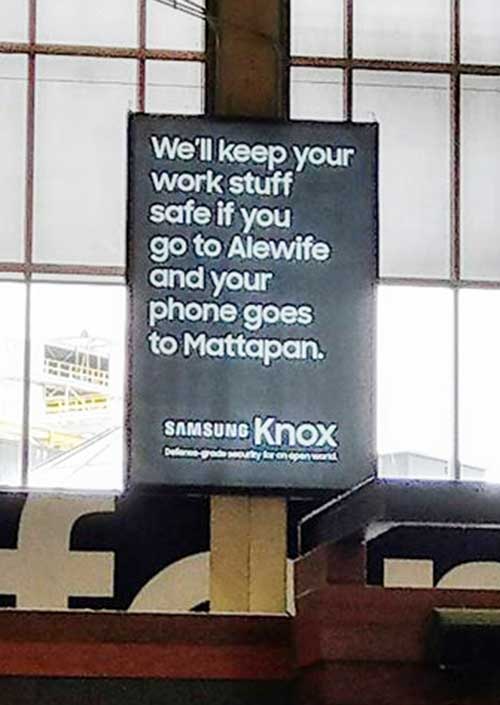Samsung ad evokes racial stereotypes
South Station ads envision a victim going to Alewife, a thief to Mattapan

Commuters did a double take when faced with ads hanging in South Station last week. Posters that promoted a security system designed to protect cell phones in case of theft seemed to tout demeaning racial stereotypes.
“We’ll keep your work stuff safe if you go to Alewife and your phone goes to Mattapan,” stated the Samsung Knox advertisements.
A photo of the ad posted on the Banner’s Facebook page sparked a flurry of comments. Many said it seemed hardly coincidental that the advertisers envisioned their thief going to a station in a primarily black neighborhood, while their victim went to a station bordering two primarily white and affluent municipalities.
“Advertising plays into hopes and anxieties,” wrote one commenter on Facebook. “In this case, they’re selling the illusion that an object can keep you (as an extension of your possessions) carefree in a place where the presence of black people causes you anxiety. They knew what they were doing with the names ‘alewife’ and ‘mattapan’.”
“I teach in Mattapan. My lovely students and their families live in Mattapan,” another commenter stated. “Holy crap. …. A group of people discussed this idea and thought it was okay. A printing company saw the design and thought it was okay. The T saw the sign and thought it was okay. I’m sure thousands of people have read it and thought it was okay. IT’S NOT OKAY.”
Bay State Banner social media posts drew the attention of City Councilor Tito Jackson and others who complained to the MBTA, which contacted the managers of South Station to have the signs removed. According to a T spokesperson, the agency was unaware of these ads until contacted about the Banner postings.
Ashkenazy, the firm that manages South Station, told the Banner last Thursday that members were in discussion with Clear Channel, the company that contracts their ads.
“We are evaluating sponsor content with our ad agency, Clear Channel. There are a couple of signs that have been identified as inconsistent with our guidelines, and have been removed. We apologize for any misinterpretations,” they said in a statement to the Banner.
Samsung issued an apology as well, stating, “As soon as we were made aware of the reaction to our South Station placement, we worked with Clear Channel to take the sign down immediately. We sincerely apologize to the people of Mattapan.”
How does this happen?
Racial stereotypes have been used by advertisers for much of America’s history.
“From the beginning of the 20th century to the mid-1960s, advertising using stereotypical images of African-Americans was pervasive throughout the U.S.,” states Advertising Age. “From the end of slavery to the period of the Civil Rights movement in the 1960s, ads in the U.S. continued to show blacks as Aunt Jemimas, Uncle Bens and Rastuses — individuals subservient to whites.”
Racial and gender stereotypes are less common today, but still appear, said Kathy Kiely, president of the Ad Club, New England’s trade association for the marketing, and communications industry. In general, she said, the use of stereotypes in ads has greatly declined as social media attention and national conversations make agencies increasingly sensitive to their messages’ implications.
“We’re all exposed to international brands and the world is shrinking through social media,” Kiely said. “However, you still see stereotyping in advertising. You still see the dumb husband who can’t do anything right at home. You still see the perky mother who’s thrilled her floors sparkle. We have a way to go as far as gender and race being stereotyped in advertising. … In general though, people are way more focused on ending that.”
Kiely said that the Samsung ad seemed to be an attempt to add local flair — something advertisers do to try to appear to relate to audiences — but was handled in a deeply misguided way.
“I think advertisers have to be hyper-sensitive. … Advertisers really need to check what they’re doing and look at their own bias,” Kiely said. “We have to pay attention because it does matter. Another two minutes spent on that [Samsung Knox] ad, and they’d say, ‘That’s profiling.’ … With social media and everything that’s happening in the country, everyone’s on high alert for something like this.”
All ads go through many hands before approval and release, she explained. One step that would help? Better diversifying the advertising industry, whose ranks remain largely homogeneous.






